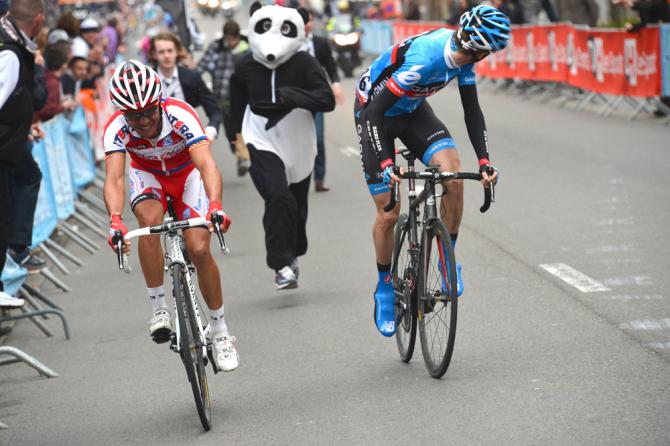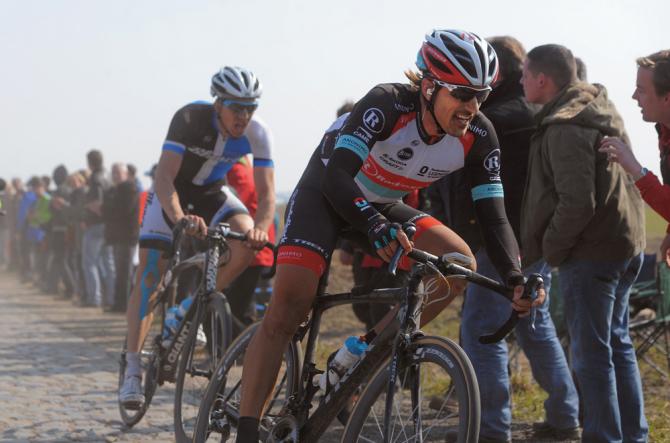Cyclingnews' Guide to the 2014 Spring Classics
Your guide to the 2014 Spring Classics: Updated 1/4/2014







Milan-San Remo - March 23
Milan-San Remo is one of most delicately balanced races on the calendar, and there is arguably no other Classic that has such a long list of potential victors. Ostensibly, the largely flat route and fast finale heavily favours the sprinters, but after seven hours of racing, the famous capi on the approach to San Remo swell from mere ripples to severe obstacles that can be the graveyard of so many sprinters’ ambitions and the Classics stars will have their say, too, during the 298km race.
Past winners include Gerald Ciolek, Simon Gerrans, Mark Cavendish, and Fabian Cancellara, with all four set to line up for the 2014 edition.
What happened in 2014?
Alexander Kristoff (Katusha) won the 105th Milan-San Remo taking the sprint ahead of Fabian Cancellara (Trek Factory Racing) and Ben Swift (Team Sky). He easily pulled away in the closing meters after a perfect leadout from his teammate Luca Paolini.
What happened last year?
Gerald Ciolek (MTN-Qhubeka) won a shortened version of Milan-San Remo, as snow forced organisers to cut the first two climbs. The German sprinter took the close win ahead of Peter Sagan (Cannondale) and Fabian Cancellara (RadioShack-Leopard) in a thrilling sprint finish.
The latest race content, interviews, features, reviews and expert buying guides, direct to your inbox!

Fabian Cancellara says: “It’s a special race with a story behind it. It’s like a bottle of champagne, you shake it , you shake it more and then you open it. It’s all about the final two climbs and saving energy. When I won everyone knew not to give me 10 meters but they gave me just one and that was too much."
2013 Milan-San Remo race report | 2013 Milan-San Remo photos | 2012 Milan-San Remo | 2011 Milan-San Remo | Past winners
Gent-Wevelgem - March 30
Known for its climb and dicey descent of the Kemmelberg, which was previously the only difficulty in the race, the course features 16 bergs including the Kemmel and a slightly longer parcours.
The early part of the race takes place near Belgium's North Sea coast line, which means high winds often shatters the peloton into bits.
What happened this year?
John Degenkolb (Giant-Shimano) sprinted to victory at Gent-Wevelgem ahead of Arnaud Demare (FDJ.fr) and Peter Sagan (Cannondale) after a high-speed, hectic race on the hills and WW1 battle fields of Flanders. Sep Vanmarcke (Belkin) placed fourth, followed by Tom Boonen (Omega Pharma-QuickStep) in fifth in the sprint but a crash took down Andre Greipel (Lotto Belisol) and Tyler Farrar (Garmin-Sharp) in the final kilometres.
What happened last year?
Peter Sagan (Cannondale) soloed to the win in the 2013 Gent-Wevelgem, launching a winning attack from a breakaway inside the final four kilometres. He finished clear of Borut Bozic (Astana) and Greg Van Avermaet (BMC), with the sprinters left competing for the minor places in a race shortened by the snowy conditions.

2013 Gent-Wevelgem race report | 2013 Gent-Wevelgem photos | 2012 Gent-Wevelgem | 2011 Gent-Wevelgem | Past winners
Tour of Flanders - April 6
The Tour of Flanders has seen another set of route changes for 2014 but the same old favourites in Tom Boonen, Fabian Cancellara and Peter Sagan should still all feature.
The Oude Kwaremont still features three times – which is not surprising given the success of the huge VIP tent that is now erected alongside it – but the Paterberg now only features twice. These two hills remain the final pair on the route, which ensures the relatively lengthy run-in to the finish to Oudenaarde is unchanged.
What happened last year?

Sagan easily out-kicked Roelandts for second place while Alexander Kristoff (Katusha) led in the chase group for fourth 10 seconds later.
Fabian Cancellara says: "The whole day is special. You go to Belgium, to Flanders, and it’s another world with so much passion for racing. The strongest rider should come out on top but you have to work at everything. You need your team, you need luck but it’s one of the hardest one day races in the season."
2013 Tour of Flanders race report | 2013 Tour of Flanders photos | 2012 Tour of Flanders | 2011 Tour of Flanders | Past winners
Paris-Roubaix - April 13
There is no other race in the world like Paris-Roubaix. The French race is known as the 'Hell of the North' thanks to its torturous pavé sectors and the many stories of pain and destruction that they hold.
Dreams of riders like George Hincapie and Johan Museeuw have ended in tears along the roadside, but the risks make victory in the velodrome that much sweeter. After 260 kilometres, around 50 on pavé, the race ends with one and a half laps on Roubaix's outdoor track.
Win in Roubaix, the third of the Monuments, and you are considered a god. Riders like Fausto Coppi, Rik Van Looy, Eddy Merckx, Francesco Moser, Sean Kelly and Tom Boonen have tamed Paris-Roubaix's pavé for the well-earned status.
What happened last year?
Fabian Cancellara (RadioShack Leopard) pulled off a thrilling performance to win the 2013 Paris-Roubaix in a dramatic sprint finish with Sep Vanmarcke (Blanco). Niki Terpstra (Omega Pharma QuickStep) sealed the final place on the podium.
Fabian Cancellara says: "I have many beautiful memories of this race. I know how to adapt to this race, and I like the challenges it poses from a technical point of view but you need the luck. Sometimes it’s like an individual time trial, though, and along with luck you need to be smart."
2013 Paris-Roubaix race report | 2013 Paris-Roubaix photos | 2012 Paris-Roubaix | 2011 Paris-Roubaix | Past winners
The Dutch Classic Amstel Gold Race has a character all of its own: twisty and narrow roads, short and steep climbs, and crazed orange-clad fans. The first of three Ardennes Classics is a race to watch and one for the riders to add to their palmarès.
The relatively new Classic (this year celebrating its 48th edition) starts in Maastricht and ends with three circuits on the Cauberg. The first two times up the 1.5-kilometre climb splits the race into select groups, while the final ascent decides the race winner.
Home teams Giant-Shimano and Belkin will go all-out to make their presence felt in this race, but in recent years they have fallen short of the victory. Italians have made this race theirs since Erik Dekker last won for Rabobank and the Netherlands in 2001.
What happened in 2013?
2013 Amstel Gold Race race report | 2013 Amstel Gold Race photos | 2012 Amstel Gold Race | 2011 Amstel Gold Race | Past winners
La Flèche Wallonne - April 23
Belgium's Flèche Wallonne is a mid-week race with a short distance of 200 kilometres, but that does not change the importance of this race that always ends with spectacular explosions on the famed Mur de Huy. The climb is a 1,300-metre, leg-snapping ascent that averages 9.3 percent gradient and boasts a maximum of 25 percent.
The second of three Ardennes Classics starts at a leisurely pace in the Walloon city of Charleroi, but it ends with two rings of fire (if you will) around the city of Huy. The riders scale the Mur de Huy the first time to start the smaller circuit that ends with Huy. From there it is all about positioning for the final larger circuit: Côte de Peu d'Eau, Côte de Haut-Bois, Côte de Thon, Côte de Bonneville, Côte de Bohissau, Côte de Ahin and Mur de Huy.
Riders need to be in the front 15 for the Mur de Huy. Then, whoever wants to win needs to wait to the last three-hundred metres to light his dynamite. A well-timed blast will produce a victory, but an early move will mean you are gasping for breath on the fan-lined Mur.
What happened in 2013?
Daniel Moreno carefully bided his time on the steepest section of the final climb and then accelerated off Philippe Gilbert’s shoulder in the closing 200 metres. Sergio Henao (Sky) emerged from the carnage behind to take second place at three seconds, while Carlos Betancur at least had the consolation of holding off a rapidly-finishing Dan Martin (Garmin-Sharp) for the third step on the podium.

2013 Flèche Wallonne race report | 2013 Flèche Wallonne photos | 2012 Flèche Wallonne | 2011 Flèche Wallonne | Past winners
Liège-Bastogne-Liège - April 27
Liège-Bastogne-Liège ends the run of Northern Classics that started with the Tour of Flanders and settles the week-long Ardennes Classics supremacy battle. It packs numerous côtes on the out-and-back run from the suburb of Ans, just south of Liège.
On the return journey to Ans, the favourites will start to move forward in the pack. One of the toughest battles will be waged on the 2.1-kilometre La Redoute, coming at kilometre 226 and 35 kilometres from the finish. La Redoute will be an indicator of how the race will continue to unfold over the three following côtes of Sprimont (-29km), Roche aux Faucons (-19.5km) and Saint-Nicolas (-5.5km).
The finish to Ans is not considered one of the official climbs, but it rises steadily over the final two kilometres.
La Doyenne ('The Grand Old Lady') is the fourth of cycling's five Monuments. The fifth Monument, Il Lombardia, comes almost six months later.
What happened last year?
Daniel Martin (Garmin-Sharp) won a thrilling Liege-Bastogne-Liege, powering clear of Joaquim Rodriguez (Katusha) in the final few hundred meters to seal his first Classics victory. The Irishman was set up for the win by teammate Ryder Hesjedal who attacked on the penultimate climb of the race and then held a crucial chase group together before the final drag to the finish in Ans.

2013 Liège-Bastogne-Liège race report | 2013 Liège-Bastogne-Liège photos | 2012 Liège-Bastogne-Liège | 2011 Liège-Bastogne-Liège | Past winners
